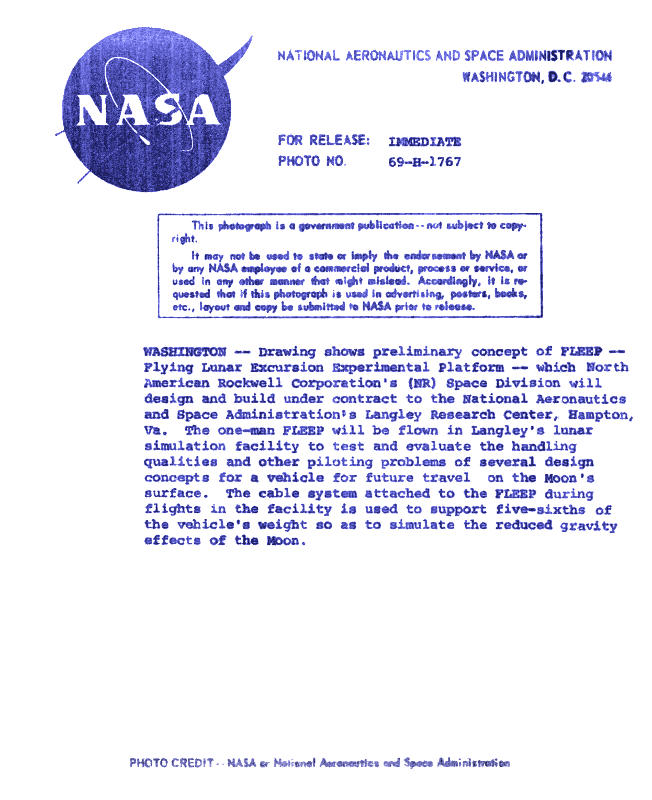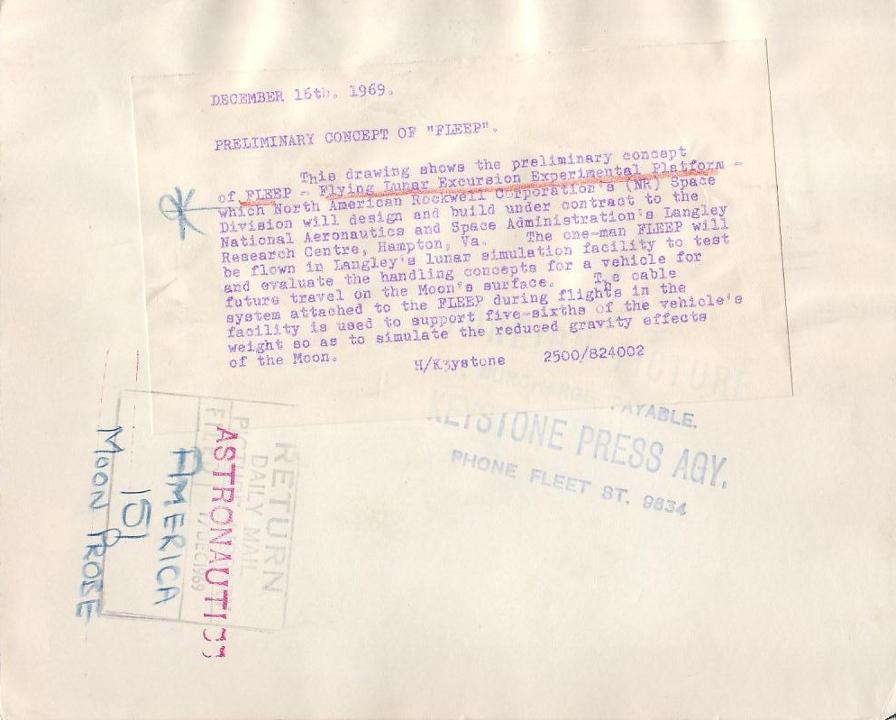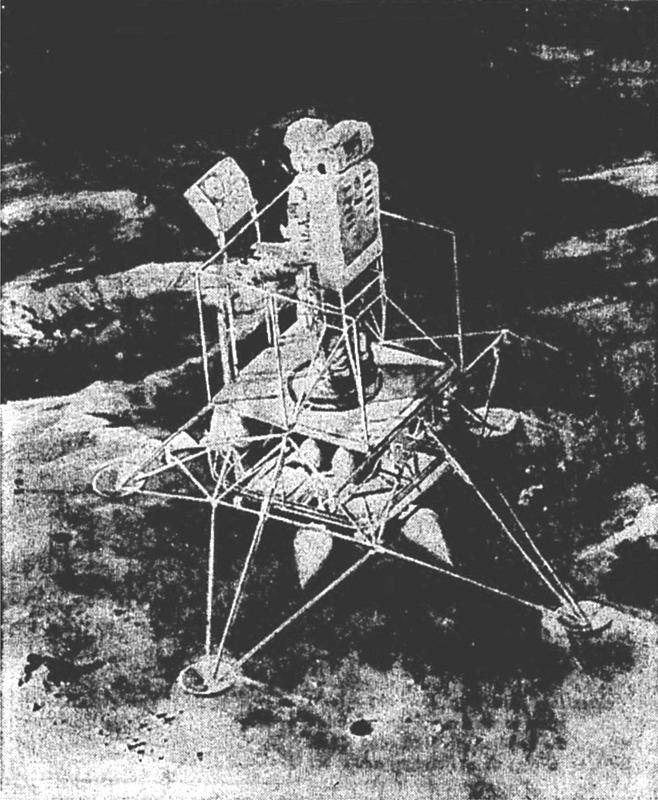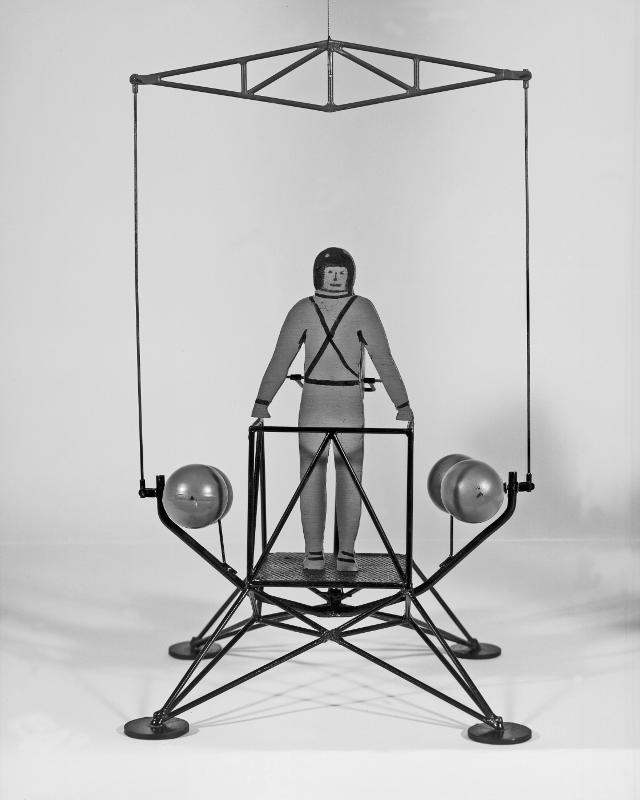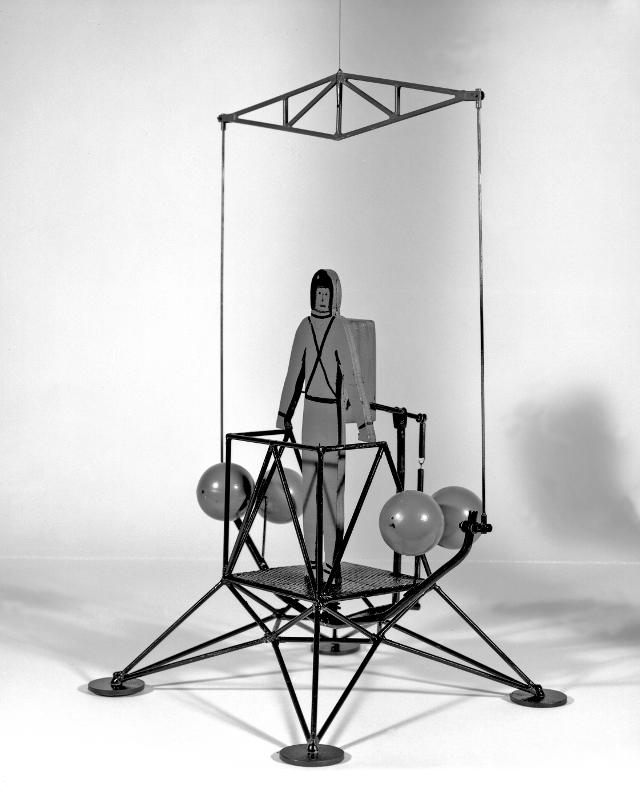Flying Lunar Excursion Experimental Platform (FLEEP)
The Flying Lunar Excursion Experimental Platform, or FLEEP, was used in a research program to explore and evaluate design approaches for a lunar flying vehicle. Handling and other piloting problems were studied with the pilot in a standing position in the simulated lunar gravity field with six degrees of freedom.
The FLEEP was one of a number of one- or two-man flying lunar vehicle concepts designed to extend the exploration radius of the Apollo astronauts. It was designed to be tested in Langley Research Center's Lunar Landing Research Facility, an A-frame steel gantry 400 feet long and 230 feet tall. Below is an artist's conception of the FLEEP being tested in in the LLRF:
Click image for a 1138x1426 pixel version of this image in a new window.
From an eBay auction.
Cleanup by heroicrelics.
This photo appears to have been issued under at least two guises, as NASA photo 69-H-1767 and as a press agency release, with similar yet slightly different captions.
Here's the back of NASA photo 69-H-1767:
Click image for a 1246x1530 pixel version of this image in a new window.
From an eBay auction.
Reconstruction by heroicrelics.
The photo's caption reads
For Release: Immediate
Photo No. 69-H-1767WASHINGTON -- Drawing shows preliminary concept of FLEEP -- Flying Lunar Excursion Experimental Platform -- which North American Rockwell Corporation's (NR) Space Division will design and build under contract to the National Aeronautics and Space Administration's Langley Research Center, Hampton, Va. The one-man FLEEP will be flown in Langley's lunar simulation facility to test and evaluate the handling concepts and other piloting problems of several design concepts for a vehicle for future travel on the Moon's surface. The cable system attached to the FLEEP during flights in the facility is used to support five-sixths of the vehicle's weight so as to simulate the reduced gravity effects of the Moon.
The alternate back of the photo:
Click image for a 994x799 pixel version of this image in a new window.
From an eBay auction.
Cleanup by heroicrelics.
This caption reads
December 16th, 1969
PRELIMINARY CONCEPT of "FLEEP"
This drawing shows the preliminary concept of FLEEP - Flying Lunar Excursion Experimental Platform - which North American Rockwell Corporation's (NR) Space Division will design and build under contract to the National Aeronautics and Space Administration's Langley Research Center, Hampton, Va. The one-man FLEEP will be flown in Langley's lunar simulation facility to test and evaluate the handling concepts for a vehicle for future travel on the Moon's surface. The cable system attached to the FLEEP during flights in the facility is used to support five-sixths of the vehicle's weight so as to simulate the reduced gravity effects of the Moon.
H/K3ystone 2500/824002
The FLEEP concept apparently enjoyed favorable enough status (or NAR's PR department was in sufficiently high gear) around this time for the Associated Press to provide newspapers with a wire photo. The drawing below ran in newspapers across the country in October and November of 1969:
Click image for a 1164x1536 pixel version of this image in a new window.
From page 30 of the October 12, 1969 issue of the Racine Journal-Times
Bulletin.
Scan by the Newspaper
Archive.
Reconstruction by heroicrelics.
The caption for this photo reads
Proposed Lunar Surface Flyer — This drawing is an artist's conception of a Flying Lunar Excursion Experimental Platform, or FLEEP, that North American Rockwell's Space Division has announced plans to design under a contract with NASA's Langley Research Center. The one-man flyer will be tested in a simulation facility at Langley to evaluate designs for lunar surface flyers.
The FLEEP design seems to have been fairly well-settled by the end of 1969 (when the two photos above were released). I've seen microfiche of eight different FLEEP-related documents, dated January 1970 through July 1970, which describe the same basic design, which is largely the same as the FLEEP vehicle at the U.S. Space & Rocket Center.
I also have two photos of a scale model of the FLEEP, circa 1967 (at least two years before the drawings above), showing a much rougher design:
NASA photo 1967-L-07383.
Photo courtesy Langley Research Center via the U.S. Space & Rocket Center.
NASA photo 1967-L-07379.
Photo courtesy Langley Research Center via the U.S. Space & Rocket Center.
Although crude compared to the artists impressions above, the basic design is represented (an astronaut standing on a platform supported by four legs) and the arrangement of the leg struts is nearly identical to the final result.
I don't know exactly how far the development of the FLEEP progressed before cancellation. The contract for the Lunar Roving Vehicle was let in late 1969, calling for delivery of the first LRV by April 1971. NASA was becoming more cautious by this time as well, and a vehicle keeping four wheels on the ground (well, at least most of the time) was much safer than a "flying skateboard" which would have an astronaut balancing on rocket exhaust over the lunar surface.
The only surviving hardware of which I am aware is at the U.S. Space & Rocket Center (on loan from Langley); the USSRC curator is similarly of the opinion that theirs is the only one ever built. However, the USSRC article has dummy thrust chambers currently installed on it, and I've seen a microfiche copy of the Flying Lunar Excursion Experimental Platform Operation and Maintenance Manual (dated June 1970) which includes information about the thrust chambers ("The T/Cs are mounted in gimbals which can be positioned by the pilot to control the thrust vectors in the pitch-roll modes," "Each thrust chamber is designed to produce 126 ± 6 pounds of thrust with a nominal chamber pressure of 315 psia") and the propellant feed system ("a spherical tank for the 90% Hydrogen Peroxide (H2O2), a quick-disconnect fitting ..., a tank vent valve, a manually operated H2O2 drain valve, a low-pressure relief valve, a main shut-off valve, a 0-1000 psig pressure gage[sic], and associated lines and fittings necessary to feed the propellant to the main thruster and the auxiliary thruster system"). This manual seems to describe a test article with a functional propulsion system.
So, it seems that either the testing thrust chambers were replaced on the USSRC FLEEP for display purposes or that there were multiple vehicles built.
Although I was unable to find much information on the Internet about the FLEEP itself, the FLEEP program fed into several other designs. For additional reading on the FLEEP's contributions to these follow-on programs, see Studies of Piloting Problems of One-Man Flying Units Operated in Simulated Lunar Gravity, the One Man Lunar Flying Vehicle Final Report, and the Lunar Escape Systems (LESS) Feasibility Study.


